Sorting out semiconducting single-walled carbon nanotube arrays by preferential destruction of metallic tubes using water†
Abstract
The coexistence of metallic (m-) and semiconducting (s-)

* Corresponding authors
a
Center for Nanochemistry, Beijing National Laboratory for Molecular Sciences, Key Laboratory for the Physics and Chemistry of Nanodevices, State Key Laboratory for Structural Chemistry of Unstable and Stable Species, College of Chemistry and Molecular Engineering, Peking University, Beijing, P.R. China
E-mail:
jinzhang@pku.edu.cn
Fax: +86-10-6275-7157
Tel: +86-10-6275-7157
The coexistence of metallic (m-) and semiconducting (s-)

 Please wait while we load your content...
Something went wrong. Try again?
Please wait while we load your content...
Something went wrong. Try again?
P. Li and J. Zhang, J. Mater. Chem., 2011, 21, 11815 DOI: 10.1039/C1JM10399G
To request permission to reproduce material from this article, please go to the Copyright Clearance Center request page.
If you are an author contributing to an RSC publication, you do not need to request permission provided correct acknowledgement is given.
If you are the author of this article, you do not need to request permission to reproduce figures and diagrams provided correct acknowledgement is given. If you want to reproduce the whole article in a third-party publication (excluding your thesis/dissertation for which permission is not required) please go to the Copyright Clearance Center request page.
Read more about how to correctly acknowledge RSC content.
 Fetching data from CrossRef.
Fetching data from CrossRef.
This may take some time to load.
Loading related content
